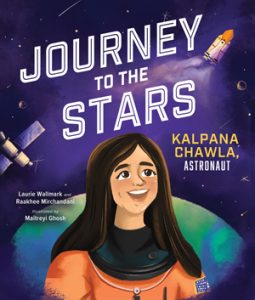Talking About Women’s History: Three Questions and an Answer with Laurie Wallmark
If you’ve hung out here at the Margins, you’ve probably read one of my occasional paeans to the biographies of kick-ass women that were in the library in my elementary school. (In fact, now that I think about it, the subject came up in a Q & A with Kip Wilson earlier this month.) They inspired my life-long interest in women’s history.
Today’s guest, Laurie Wallmark, writes similar biographies, aimed at slightly younger readers, with the twist that she focuses on women in STEM which means she may well be inspiring young engineers, scientists, coders, and astronauts as well as baby historians. Before she began writing, Laurie worked as a software engineer, a computer science professor and the owner of an internet-based bookstore. (Before Amazon! )
She is the author of seven picture book biographies of women in STEM: THE QUEEN OF CHESS (Little Bee, 2023), HER EYES ON THE STARS (Creston Books, 2023), CODE BREAKER, SPY HUNTER (Abrams, 2021); NUMBERS IN MOTION (Creston Books); HEDY LAMARR’S DOUBLE LIFE (Sterling Children’s Books, 2019); GRACE HOPPER: QUEEN OF COMPUTER CODE (Sterling Children’s Books, 2017); and ADA BYRON LOVELACE AND THE THINKING MACHINE (Creston Books, 2015).
Take it away, Laurie!
The biographies you write all deal with women in STEM. How do you make complex ideas understandable to young readers?
When I was in grad school (MFA in writing), I wrote my thesis on how to explain STEM (Science, Technology, Engineering, and Math) in picture books. The title of my thesis? “It’s Complicated (Not Really).” There are so many techniques an author can use to provide kids the tools they need to understand complex STEM ideas and concepts. It’s up to the author to choose the ones that will work for each situation. From word choice to in-text definitions, analogies to relatable context, even the most difficult information can be made understandable. For example, in my book Numbers in Motion, I say that partial differential equations define the rules about how something changes. That’s all that the reader needs to know. They don’t need to understand the complicated mathematics behind these equations.
How do you choose subjects for your biographies?
There are two main questions I ask myself when choosing a subject. First, do I think the person’s life and accomplishments will be interesting to and second, will it have meaning for a child. If not, why write it?
After that, I consider additional questions. Is there enough source material available? Are there already recent books written about the person. Finally, am I drawn to learning more about the person? After all, in writing a biography, you have to spend a lot of time immersing yourself in the person’s world.
Do you think Women’s History Month is important and why?
In a perfect world, we wouldn’t need a month dedicated to the history of a specific group (like women, Black people, LGBT people, etc. ) The story of their lives would be part of the general history that kids learn about. But, let’s just say we don’t live in a perfect world. The accomplishments of underrepresented groups are often overlooked or minimized. Having months like Women’s History Month, gives educators an opportunity to shine a light on the achievements of members of these groups.
A question from Laurie: Do you think that by having a month dedicated to women’s history, it gives people an excuse to ignore women’s contributions during the rest of the year?
Maybe it’s wishful thinking on my part, but I think that is less and less true with time.
Since Women’s History Month was created in 1987, at least two generations have grown up learning about women’s history each year in school. Numbers of them have gone on to highlight women’s history in exciting ways outside of March—some of whom have appeared here on the Margins over the years. And it is clear they have an audience.
***
Want to know more about Laurie Wallmark and her work?
Check out her website: https://www.lauriewallmark.com/
Like her on Facebook: Laurie Wallmark – author
Follow her on the platform previously known as Twitter: @lauriewallmark
Follow her on Instagram: lauriewallmark https://www.instagram.com/lauriewallmark/
Follow her on Bluesky: @lauriewallmark.bsky.social
***
Tomorrow it will be business as usual here on the Margins with a blog post from me. Then we’ll be back on Monday with Jennifer Lunden, author of Americana Breakdown.






